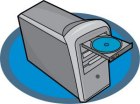Computer is a machine that manipulates records according to a list of instructions. The first procedure that resemble recent computers date to the mid-20th century (around 1940 - 1945), although the computer concept and various machines similar to computers existed earlier. Early electronic computers were the size of a large room, overwhelming as much command as several hundred modern personal computers. Modern computers are based on tiny integrated circuits and are millions to billions of times more competent while occupying a fraction of the space. Today, simple computers may be made small enough to fit into a wristwatch and be powered from a watch battery. Personal computers, in various forms, are icons of the Information Age and are what most populace think of as "a computer"; however, the most common form of computer in use today is the entrenched computer. Embedded computers are small, simple devices that are used to manage other devices — for example, they may be found in machines ranging from fighter jet to industrial robots, digital cameras, and children's toys.
The capacity to store and implement lists of instructions called programs makes computers extremely multitalented and distinguishes them from calculators. The cathedral–Turing hypothesis is a mathematical statement of this versatility: any computer with a certain minimum capability is, in principle, capable of performing the same responsibilities that any other computer can perform. Therefore, computers with capability and complexity ranging from that of a personal digital assistant to a supercomputer are all able to perform the same computational tasks given enough time and storeroom capacity.
It is difficult to identify any one device as the earliest computer, partly because the term "computer" has been subject to varying interpretations over time. Originally, the term "computer" referred to a person who performed mathematical calculations (a human computer), often with the aid of a mechanical calculating tool.
Wednesday, May 27, 2009
Subscribe to:
Post Comments (Atom)





No comments:
Post a Comment